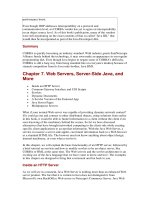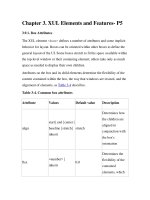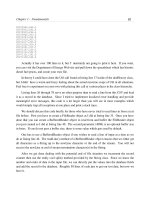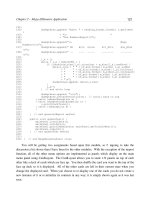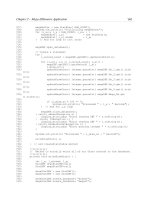About Java and xBaseJ- P5
Bạn đang xem bản rút gọn của tài liệu. Xem và tải ngay bản đầy đủ của tài liệu tại đây (1008.01 KB, 20 trang )
Chapter 1 – Fundamentals
20070905,289.3
20070912,292.4
20070919,296.4
20070926,303.2
20071003,304.8
20071010,303.5
20071017,303.9
20071024,309.4
20071031,315.7
20071107,330.3
20071114,342.5
20071121,341.0
20071128,344.4
Actually it has over 100 lines in it, but I'm certainly not going to print it here. If you want,
you can visit the Department of Energy Web site and pull down the spreadsheet which has historic
diesel fuel prices, and create your own file.
In theory I could have done the Util call found at listing line 17 inside of the doeHistory class,
but I didn't have a warm and fuzzy feeling about the actual runtime scope of Util in all situations.
Feel free to experiment on your own with placing this call at various places in the class hierarchy.
Listing lines 26 through 78 serve no other purpose than to read a line from this CSV and load
it as a record in the database. Since I tried to implement localized error handling and provide
meaningful error messages, this code is a lot larger than you will see in most examples which
would simply trap all exceptions at one place and print a stack trace.
We should discuss this code briefly for those who have never tried to read lines in from a text
file before. First you have to create a FileReader object as I did at listing line 33. Once you have
done that you can create a BufferedReader object to read from and buffer the FileReader object
you just created as I did at listing line 40. The second parameter (4096) is an optional buffer size
in bytes. If you do not pass a buffer size, there is some value which gets used by default.
One has to use a BufferedReader object if one wishes to read a line of input at a time as we
do at listing line 46. The readLine() method of a BufferedReader object ensures that we either get
all characters as a String up to the newLine character or the end of the stream. You will not
receive the newLine or end of stream termination character(s) in the String.
After we get done dealing with the potential end of file situation we increment the record
counter then use the really cool split() method provided by the String class. Since we know the
number and order of data in the input file, we can directly put the values into the database fields
and add the record to the database. Roughly 50 lines of code just to get our test data, but now we
have it.
81
Chapter 1 Fundamentals
Listing lines 84 through 147 contain the meat of this test. We need to see the output before
we talk about them, though.
roland@logikaldesktop:~/fuelsurcharge2$ java testDoeHistory
Populating database
End of input file reached
Finished adding 107 records
Result of add 1
result of second add 1
First 10 in order added
Date Price
-------- ----------
20070905 89.300
20070912 92.400
20070919 96.400
20070926 03.200
20071003 04.800
20071010 03.500
20071017 03.900
20071024 09.400
20071031 15.700
20071107 30.300
First 10 in descending date order
Date Price
-------- ----------
20090916 63.400
20090909 64.700
20090902 67.400
20090826 66.800
20090819 65.200
20090812 62.500
20090805 55.000
20090729 52.800
20090722 49.600
20090715 54.200
First 10 in ascending date order
Date Price
-------- ----------
20070905 89.300
20070912 92.400
20070919 96.400
20070926 03.200
20071003 04.800
20071010 03.500
20071017 03.900
20071024 09.400
20071031 15.700
20071107 30.300
Before reIndex
finding 20071010
Result of EQ find 1
Date: 20071010 Price: 03.500
82
Chapter 1 – Fundamentals
Result of get_newest 1
Date was: 20090916
After reIndex
First 10 in descending date order
Date Price
-------- ----------
20121003 13.410
20110830 29.950
20090916 63.400
20090909 64.700
20090902 67.400
20090826 66.800
20090819 65.200
20090812 62.500
20090805 55.000
20090729 52.800
finding 20071010
Result of EQ find 1
Date: 20071010 Price: 03.500
Result of delete 1
Result of get_newest 1
Date was: 20121003
You should note that the result of both the first add (20121003, 13.41) and the second add
(20110830, 29.95) returned a 1, meaning they were successfully added to the database, yet they
didn't show up on our initial dump reports. The records don't show up until
after
I call reIndex().
Here is another lovely little tidbit for you. NDX objects don't monitor changes. If, instead of
obtaining the the NDX currently attached to the DBF object, I simply create two new objects and
reindex, those changes will be reflected in the file, but not in our application.
NDX a = new NDX( DEFAULT_K0_NAME, aDB, false);
a.reIndex()
NDX b = new NDX( DEFAULT_K1_NAME, aDB, false);
b.reIndex()
The code above will not place entries in our index even though the values will be correct on
file. Why? Because the Btree gets loaded into RAM. You have to manipulate the exact same
Btree the database object is using. Make no mistake, a call to reIndex() changes the contents of
the file, but the other loaded view of it does not.
You should never, under any circumstances,
attempt to let multiple users have write access to the same DBF for this, and many other, reasons.
There is no triggering method in place to keep Btrees in synch because there is no database engine
in place.
83
Chapter 1 Fundamentals
Take another look at listing line 463 in doeHistory.java. I have the useIndex() for the second
key commented out. On page twelve in this book I told you that records could be added to a DBF
file without ever creating an entry in an index file. This test has been a shining example. When
we call open_database() we only open one index. Indeed, the database object doesn't care if we
choose to not open any. A good many xBASE libraries out there support only reading and
writing of records in xBASE format. They provide no index support whatsoever.
1.121.12
1.121.12
1.121.12
Programming Assignment 4Programming Assignment 4
Programming Assignment 4Programming Assignment 4
Programming Assignment 4Programming Assignment 4
This is a multipart assignment. Your first assignment is to uncomment listing line 463,
recompile and rerun this application. You will note that the first set of dump reports now has the
added records. Can you explain why?
Part 2: Move all of the dump_ methods out of doeHistory.java and make them methods in
testDoeHistory.java. Get them to actually work. DO NOT MAKE THE DBF OBJECT PUBLIC
OR USE A METHOD WHICH PROVIDES A COPY OF IT TO A CALLER. Don't forget to
check for the database being open prior to running. Do not add any new methods to
doeHistory.java.
Part 3: After completing part two, change getNext() to use read() instead of findNext(),
compile and document what, if any, difference there is in the output.
Part 4: After completing part three, add one method to doeHistory.java which uses the
readPrev() method of the DBF class to read the previous record. Clone the dump_first_10_k1()
method you just moved to testDoeHistory.java to a method named dump_last_10_k0(). Without
using the alternate index, get the same 10 records to display.
84
Chapter 1 – Fundamentals
1.13
1.131.13
1.131.13
1.13
Deleting and Packing
Deleting and PackingDeleting and Packing
Deleting and PackingDeleting and Packing
Deleting and Packing
I mentioned much of this information earlier but we are going to go over it again in detail
because it tends to catch most newbies offguard even after they have been told a hundred times.
Deleting a record in an xBASE file does not physically delete the record (in most versions), nor
does it update any NDX index file information. (A production MDX is a slightly different
situation.)
Basically, each record in a DBF file has an extra byte at the front of it. When that byte is
filled in, usually with an asterisk, the record is considered to be “deleted .” Your applications will
continue to read this record and process it unless they call the deleted() method immediately after
reading a record. The deleted() method of the DBF class returns true if the record is flagged for
deletion.
One of the dBASE features general users found most endearing was the ability to “und elete”
a record they had accidentally deleted. This feature was possible simply because the record had
not been physically deleted. The DBF class provides an undelete() method for you as well. If you
find a record which has been marked as deleted that you wish to restore, you simply read it and
call undelete().
It is not unusual to find xBASE files which have never had deleted records removed. As long
as a user never hits the 2GB file size limit for a DBF, there is nothing which forces them to get rid
of deleted records. Until you hit a size limit (either maximum file size or run out of disk space),
you can just go happily on your way.
What if you want to get that space back? What if you need to get it back? Well, then you
need to know about the pack() method of the DBF class. Many books will tell you that pack()
removes the deleted records from your database. There may actually be an xBASE toolset out
there somewhere which actually implements pack() that way. Almost every library I have used
throughout my career does what xBaseJ does. They create a shiny new database with a temporary
file name, copy all of the records which are not flagged for deletion to the temporary database,
close and nuke the original database, then rename/copy the temporary back to where the original
database was. If you are looking to pack() because you are out of disk space, it is probably
already too late for you unless your /tmp or tmp environment variable is pointing to a different
physical disk.
Careful readers will note that I didn't say anything about your index files. pack() couldn't care
less about them. If you do not reindex your index files or create new index files after calling
pack(), then you are asking for disaster.
85
Chapter 1 Fundamentals
testpackDoeHistory.java
1) ...
2) System.out.println( "Finished adding " + l_record_count +
3) " records\n");
4) //
5) // Now that we have some data, let's use some
6) // of the other methods
7) //
8) // We need to delete a few records now
9) for ( int i=1; i < 20; i +=3)
10) d.delete_record( i);
11)
12) // First make sure the open works
13) d.close_database();
14)
15) // Cheat because I didn't supply the pack method
16) //
17) try {
18) DBF aDB = new DBF(d.DEFAULT_DB_NAME);
19) System.out.println( "\npacking the database");
20) aDB.startTop();
21) aDB.pack();
22) System.out.print( "\nDatabase has been packed ");
23) System.out.println( "record count " + aDB.getRecordCount());
24) aDB.close();
25) } catch( xBaseJException j) {
26) j.printStackTrace();
27) } catch( IOException e) {
28) e.printStackTrace();
29) } catch ( CloneNotSupportedException c) {
30) c.printStackTrace();
31) }
32)
33)
34) doeHistory h = new doeHistory();
35) h.open_database();
36)
37) if (!h.isOpen()) {
38) System.out.println("Unable to open the database");
39) } else {
40)
41) // add a record with a future date
42) //
43) System.out.println( "\nadding records with future dates");
44) int x;
45) x = h.add_record( "20121003", "13.41");
46) try {
47) h.effectiveDT.put( "20110830");
48) h.fuelPrice.put( "29.95");
49) } catch( xBaseJException j) { j.printStackTrace();}
50)
51) x = h.add_record();
52)
53) x = h.add_record( "20201003", "19.58");
54) x = h.add_record( "20190903", "21.58");
55) x = h.add_record( "20180803", "19.58");
56) x = h.add_record( "20170703", "21.58");
57) x = h.add_record( "20160603", "19.58");
58)
59) System.out.println( "First 10 in order added");
60) h.dump_first_10();
61) System.out.println( "First 10 in descending date order");
86
Chapter 1 – Fundamentals
62) h.dump_first_10_k1();
63) System.out.println( "First 10 in ascending date order");
64) h.dump_first_10_k0();
65)
66) // Now let us see what keys have actual
67) // data
68) //
69) System.out.println( "\n\nBefore reIndex\n");
70) System.out.println( "finding 20071010");
71) x = h.find_EQ_record( "20071010");
72) System.out.println( "\nResult of EQ find " + x + "\n");
73) System.out.println( "Date: " + h.effectiveDT.get()
74) + " Price: " + h.fuelPrice.get());
75)
76) x = h.get_newest();
77) System.out.println( "Result of get_newest " + x);
78) System.out.println( "Date was: " + h.effectiveDT.get());
79)
80) // Not all keys are updated when using NDX
81) //
82) h.reIndex();
83)
84) System.out.println( "\nAfter reIndex\n");
85) System.out.println( "First 10 in descending date order\n");
86) h.dump_first_10_k1();
87) System.out.println( "\nfinding 20071010");
88) x = h.find_GE_record( "20071010");
89) System.out.println( "\nResult of EQ find " + x + "\n");
90) System.out.println( "Date: " + h.effectiveDT.get()
91) + " Price: " + h.fuelPrice.get());
92) if ( x == h.DOE_SUCCESS) {
93) x = h.delete_record();
94) System.out.println( "Result of delete " + x + "\n");
95) }
96)
97) x = h.get_newest();
98) System.out.println( "Result of get_newest " + x);
99) System.out.println( "Date was: " + h.effectiveDT.get());
100)
101) h.close_database();
102) } // end test for successful open
103) } // end test for open dbf
104)
105) } // end main method
I did not provide the beginning of this source file because I didn't feel like reprinting the
code to load the records again. If you want to get this program running you can simply steal the
CSV import code from the previously presented program.
At listing line 9 I created a for loop which will delete records from the database. We only
need a few near the beginning to disappear.
Listing lines 18 through 24 contain the code where I open the database and call pack(). I
cheated here and directly created a database object because I had not added a pack_database()
method to the doeHistory class.
87
Chapter 1 Fundamentals
You will notice at listing lines 53 through 57 that I chose to add some more records. I just
wanted to make things painfully obvious during the rest of the test. There is nothing really magic
about the values in those records, other than the fact they are easy to spot.
Pay special attention to listing line 82. Do you remember what I said earlier? I deliberately
left this line where it was to prove that statement. Now, let's take a look at the output.
roland@logikaldesktop:~/fuelsurcharge2$ javac doeHistory.java
roland@logikaldesktop:~/fuelsurcharge2$ javac testpackDoeHistory.java
roland@logikaldesktop:~/fuelsurcharge2$ java testpackDoeHistory
Populating database
End of intput file reached
Finished adding 107 records
packing the database
Database has been packed record count 100
adding records with future dates
First 10 in order added
Date Price
-------- ----------
20070912 92.400
20070919 96.400
20071003 04.800
20071010 03.500
20071024 09.400
20071031 15.700
20071114 42.500
20071121 41.000
20071205 41.600
20071212 32.500
First 10 in descending date order
Date Price
-------- ----------
20160603 19.580
20170703 21.580
20180803 19.580
20190903 21.580
20201003 19.580
20110830 29.950
20121003 13.410
20090916 63.400
20090909 64.700
20090902 67.400
First 10 in ascending date order
Date Price
-------- ----------
20070912 92.400
20070919 96.400
20071003 04.800
20071010 03.500
20071024 09.400
20071031 15.700
20071114 42.500
88


